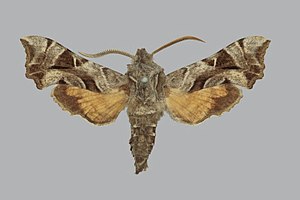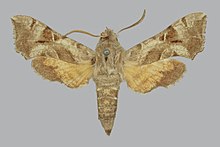Sphingona epiopsis kuldjaensis
| Sphingona epiopsis kuldjaensis | ||||||||||||
|---|---|---|---|---|---|---|---|---|---|---|---|---|

Sphingonaepiopsis kuldjaensis , male |
||||||||||||
| Systematics | ||||||||||||
|
||||||||||||
| Scientific name | ||||||||||||
| Sphingona epiopsis kuldjaensis | ||||||||||||
| ( Graeser , 1892) |
Sphingonaepiopsis kuldjaensis is a butterfly ( moth ) fromthe swarm family (Sphingidae).
features
The moths have a wingspan of 30 to 34 millimeters. They look similar to Sphingona epiopsis gorgoniades chloroptera , but have strong orange hind wings with brown margins on the outer edge. First-generation butterflies have a gray base color on the forewings, those of the second generation are lighter in color and have reddish-brown forewings rather than gray.
The small, 1.0 × 1.0 millimeter eggs are initially light green and have a strong pearlescent sheen, later they are greenish-yellow.
The caterpillars are 40 millimeters long. After hatching, they are 3.5 millimeters long and have a grayish-yellow-green color. After about an hour the color darkens to a gray-green with a faint, pale longitudinal line on both sides of the back. The body is covered with black setae and hairs. The anal horn measures 0.8 millimeters. In the second stage, the caterpillars resemble those of the genus Hemaris and have a gray-green body, a green head and a straight, black anal horn. Now wear from head to post shifter ever a wide, white ventrolateral binding and from head to Analhorn ever a less vigorous line the sides of the back. The black hairs are replaced by pale tubercles, which are distributed in even rows over the whole body. In the last stage of the caterpillar, the caterpillars are bluish-green and have white tubercles and a purple-blue anal horn. The strong band on the side can be white or white with a red border or pink. In addition to the blue-green described here, there is also a color variant with a yellow-green basic color. Before pupation, all caterpillars turn purple-reddish.
The doll is 18 to 23 millimeters long. It is glossy black and has orange-brown intersegmental skins on the abdomen. The surface of the head and thorax is slightly wrinkled and the abdomen is heavily punctured. The proboscis curves slightly forwards. The triangular Kremaster is elongated. It is flattened dorsoventrally and ends in a double point.
Occurrence and habitat
The species is known so far from the east of Kazakhstan, the west of Mongolia, the western Chinese autonomous region Xinjiang, the east of Uzbekistan as well as from Tajikistan, Kyrgyzstan and the east of Afghanistan.
It populates bushy steppes overgrown with numerous herbaceous plants between 400 meters above sea level in the Altai and up to 1250 meters above sea level in Uzbekistan.
Way of life
The male moths are active for about four to five hours from sundown, females from sundown until midnight.
Flight and caterpillar times
The moths fly from late April to early July and in a partial second generation from early July to late August. The focus of the performance is May. The caterpillars are found in Uzbekistan from May to September.
Food of the caterpillars
The caterpillars feed on bed herbs ( Galium ).
development
The females lay their eggs individually or in pairs at the tips of bedstraw sprouts. The caterpillars hatch after about seven days. Initially, the caterpillars are not very mobile and only feed on the flower buds or young leaves at long intervals. Pupation takes place in a loosely spun web between parts of the plant on the ground. The pupa hibernates. Parasitoids of the species are not known.
